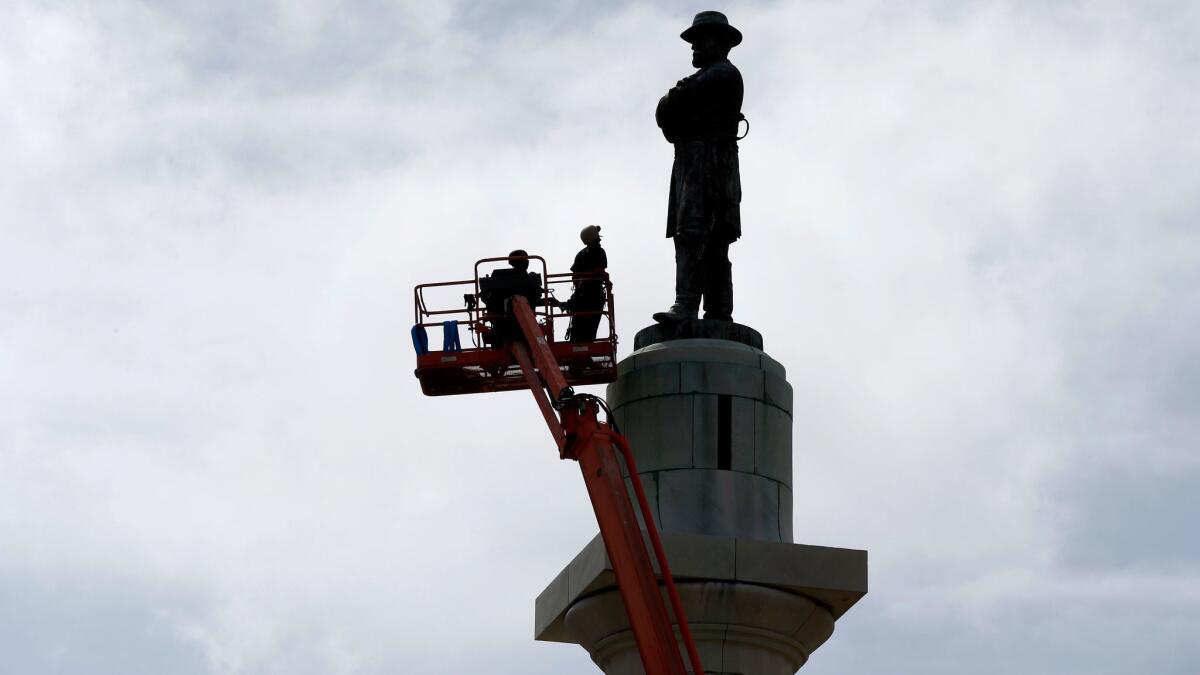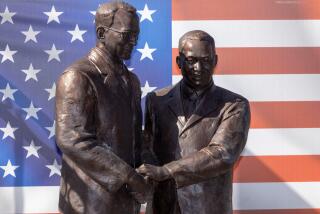New Orleans removes a statue of Confederate Gen. Robert E. Lee from its perch of 133 years

Gen. Robert E. Lee stood erect, arms crossed over his chest, as his statue was ousted from its prominent 133-year perch in the heart of New Orleans.
Just after dawn, workers in masks and protective vests had converged around Lee Circle, a traffic roundabout between the city’s bustling central business district and the wealthy Garden District neighborhood of antebellum mansions.
With hammers, chisels and ropes, they slowly prepared to dismantle the 16½-foot, three-ton bronze statue of the icon of the “Lost Cause of the Confederacy” from its lofty 60-foot tall marble column.
Before long, the event took on the aura of a block party as residents settled in with lawn chairs, parasols, even mimosas. Some strutted and shimmied as a boombox blasted James Brown’s 1968 classic, “Say It Loud — I’m Black and I’m Proud” and Public Enemy’s 1990 anthem, “Fight the Power.”
On Friday evening, a crane finally lifted Lee off his pedestal. A crowd of hundreds cheered, blew horns and sung “na na na na, na na na na, hey, hey, hey, goodbye” as the statue was lowered into a truck.
“Power to the People!” a protester chanted from a megaphone.
The towering sculpture of Lee, dedicated with great fanfare in 1884, was one of the first Confederate monuments erected in the South and the last of four contentious Civil War-related structures slated for removal by the historic Southern city.
Mayor Mitch Landrieu said Friday the Confederacy was on the wrong side of humanity.
“These statues are not just stone and metal,” Landrieu said in a special address on the monuments. “They are not just innocent remembrances of a benign history. These monuments celebrate a fictional, sanitized Confederacy, ignoring the death, ignoring the enslavement, ignoring the terror that it actually stood for.”
Not everyone agrees the monuments should be removed, with opponents saying they are part of history.
More than 150 years after the end of the Civil War — as fringe white nationalist groups have gained newfound prominence and activists with Black Lives Matter and other groups have stepped up to protest injustice — New Orleans is one of a string of Deep South cities and institutions moving to purge their public squares and streets of Confederate monuments.
About 700 Confederate-inspired monuments and statues remain on public property across the nation, with the majority dedicated or built before 1950, according to the Southern Poverty Law Center. While public scrutiny of such memorials has intensified since white supremacist Dylann Roof’s June 2015 massacre of nine black churchgoers in Charleston, S.C., the act of removing them is fraught with logistical, legal and ideological hurdles.
Relocating massive marble, bronze and granite monuments can cost tens and even hundreds of thousand dollars, money that some cash-strapped communities can ill afford. In many cases, cities and counties also face bitter resistance and lawsuits from historical groups and descendants of soldiers who accuse them of erasing history and disrespecting those who lost their lives fighting for the Confederacy.
Bitter disputes have erupted on New Orleans streets in recent weeks as the city has proceeded with its deeply contested plan to take down an equestrian statue of Confederate Gen. P.G.T. Beauregard and a bronze sculpture of Confederate President Jefferson Davis. The Battle of Liberty Place obelisk, a marble monument that celebrates the 1874 uprising of a white supremacist militia against Louisiana’s Reconstruction state government, came down in April.
“It’s a sad day for Louisiana history,” the state’s Republican Lt. Gov. Billy Nungesser said in an interview Friday. “People come to Louisiana for our rich culture and our history. Some of it is unpleasant, but it is history. You’re not going to right a wrong by taking down a monument.”
Many Louisianans, Nungesser said, would prefer to put up plaques offering a fuller, more contextualized history of the sculptures, many of which still feature plaques that glorify white supremacist interpretations of history, or erect alternative statues paying tribute to historical black leaders.
“Do we take down the Washington monument because he had slaves? Do we tear down the White House? It was built with slaves!” Nungesser said. “No one believes this will help race relations.”
Many Southern communities that have wanted to take down controversial monuments in recent years have found their efforts stall as they’ve struggled to find final resting places for symbols that many condemn as offensive.
Officials in Gainesville, Fla., and St. Louis have resolved to remove public Confederate monuments only to fail to find museums willing to house them. Officials in St. Louis this week set up a GoFundMe page to raise $25,000 to remove a monument and place it in storage.
New Orleans’ removal of four of its prominent sculptures marks a significant moment in the South’s history, a determination to challenge longstanding white supremacist symbols, said Martin Blatt, director of public history at Northeastern University and a former president of the National Council on Public History.
“All this debate and the controversy points to a history that we still badly need to confront and unearth and interrogate,” Blatt said.
He said he favored the idea of grouping the monuments at a new site, away from highly visible public space, and offering new context and interpretation.
The New Orleans movement to relocate some of the city’s most visible and controversial Confederate monuments began in earnest in 2015, shortly after the Charleston massacre, when Landrieu and the city council declared they were “public nuisances” that did not reflect the city’s diversity or full history.
The process was delayed for nearly two years by a succession of lawsuits from historic preservation groups and monument supporters. The original contractor hired by the city backed out after his employees received death threats and his car was set on fire. Workers dismantled the last three monuments in the cover of darkness, protecting themselves with masks and protective vests.
In contrast, the city announced the removal of the fourth statue, of Lee, in advance.
Throughout the years, the Lee monument has served as a focal point for Civil War reunions and a host of civic celebrations. In 1891, it was a gathering spot for the mob responsible for the largest mass lynching in American history: the killing of 11 Italian American men for their alleged role in the murder of the city’s police chief, David Hennessy.
The ultimate fate of the Jim Crow-era sculptures is uncertain. The city has stated the monuments will remain in storage until officials find a museum or facility where they can be displayed in proper context.
On Thursday, Landrieu’s office said in a statement that it had received offers from public and private institutions to take individual monuments and would solicit proposals only from governmental entities and nonprofit groups.
“This should guarantee that wherever the statues end up, they are interpreted as they should be: as historical artifacts from a time when white Southerners believed it was acceptable to memorialize a lost cause interpretation of the Civil War and ignore the historical record,” said Blain Roberts, a professor of history at Fresno State, who is working on a book about the memory of slavery.
Yet questions linger about how far New Orleans and other Southern cities will go on to memorialize the Civil War and the historic legacy of slavery.
New Orleans officials have announced that Lee’s statue will be replaced by a water feature and public art, while a U.S. flag will be placed at the site of the Davis statue. The City Park Improvement Assn. will help decide what replaces the Beauregard statue.
“Putting the American flag in the spot where the Davis statue stood is fine, but I would urge the city to do more,” Roberts said. “Whatever replaces the removed statues should acknowledge the historical facts that those statues were designed to suppress: that enslaved labor generated the wealth of white New Orleanians, and that defending slavery was the reason they and other white Southerners seceded from the Union and fought the Civil War.”
New Orleans’ removal of the monuments has prompted Louisiana lawmakers to work to enact a law that would make it harder for cities to take down Confederate monuments from public property. Four Southern states — South Carolina, Georgia, Mississippi and Tennessee — have passed similar preservation acts that block local municipalities from removing or altering historic war monuments.
On Monday, members of Louisiana’s Legislative Black Caucus walked out as the state’s Republican-dominated House passed a bill that would ban the removal of public military memorials. The next day, they said the bill revealed a “deep-rooted belief in white supremacy.”
Malcolm Suber, an adjunct professor at Southern University at New Orleans and organizer of Take ’Em Down NOLA, said the next big battle will be to remove an equestrian statue of Andrew Jackson, the seventh president of the United States, from a prominent spot in Jackson Square in the city’s historic French Quarter.
“Millions of tourists have taken photos of that statue without realizing the character of the man,” Suber said, noting the Tennessee native was a major slaveholder. “If Harriet Tubman can replace Andrew Jackson on the $20 bill, certainly we can do the same. We want to wipe the slate clean.”
Jarvie is a special correspondent.
ALSO
Dylann Roof told judge he would rather die than be labeled autistic or mentally ill
Texas announces lawsuit against local officials considered hostile toward ‘sanctuary cities’ ban
Immigrants rally in Atlanta: ‘Not one more deportation’
UPDATES:
4:40 p.m.: This article was updated with the statue’s removal and other details.
11:10 a.m.: This article was updated with additional details from the scene and comments.
This article was originally published at 10:15 a.m.
More to Read
Start your day right
Sign up for Essential California for news, features and recommendations from the L.A. Times and beyond in your inbox six days a week.
You may occasionally receive promotional content from the Los Angeles Times.







